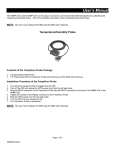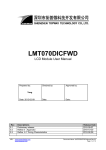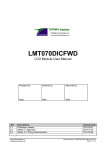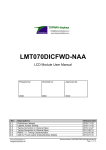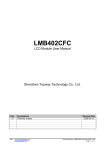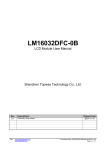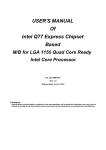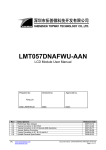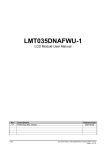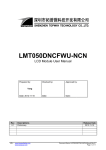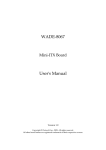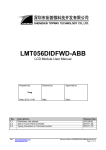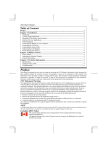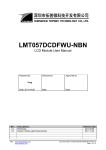Download LMT070DICFWD-NDN - topwaydisplay.com
Transcript
LMT070DICFWD-NDN LCD Module User Manual Prepared by: Checked by: Approved by: Date: Date: Yang Date: 2012-06-26 Rev. 0.1 URL: Descriptions Preliminary release www.topwaydisplay.com www.topwaysz.com Release Date 2012-06-26 Document Name: LMT070DICFWD-NDN-Manual-Rev0.1 Page: 1 of 10 TOPWAY LCD Module User Manual LMT070DICFWD-NDN Table of Content 1. General Specification ............................................................................................................ 3 2. Block Diagram........................................................................................................................ 3 3. Terminal Function.................................................................................................................. 4 3.1 BackLight Connector............................................................................................................................................. 4 4. Absolute Maximum Ratings .................................................................................................. 5 5. Electrical Characteristics ...................................................................................................... 5 5.1 Driving TFT LCD Panel .......................................................................................................................................... 5 5.2 Power On/Off Sequence ........................................................................................................................................ 6 5.3 LED Backlight Circuit Characteristics..................................................................................................................... 5 6. 6.1 AC Characteristics................................................................................................................. 6 Timing Conditions .................................................................................................................................................. 6 7. Optical Characteristics .......................................................................................................... 8 8. Precautions of using LCD Modules ...................................................................................... 9 9. Appendix <Inspection items and criteria for appearance defect>................................... 10 9.1 URL: Bright/Dark Dots:.................................................................................................................................................. 10 www.topwaydisplay.com www.topwaysz.com Document Name: LMT070DICFWD-NDN-Manual-Rev0.1 Page: 2 of 10 TOPWAY LCD Module User Manual LMT070DICFWD-NDN 1. General Specification Signal Interface : Display Mode : Screen Size(Diagonal) : Outline Dimension : Active Area : Number of dots : Pixel Pitch : Pixel Configuration : Backlight : Surface Treatment : Viewing Direction : Operating Temperature : Storage Temperature : LVDS Transmissive / Normal White 7.0” 190.0 x 112.0x 8.7 (mm) (see attached drawing for details) 154.08 x 85.92 (mm) 800 x 3 (RGB) x 480 0.0642 x 0.179 (mm) RGB Stripe LED Anti-Glare Treatment 6 o’ clock -20 ~ +70°C -30 ~ +80°C 2. Block Diagram BL_VI, BL_GND Backlight Gate Driver BL_EN, BL_ADJ 800(x3) x 480 pixels Source Driver RX0+,RX0-,RX1+,RX1RX2+, RX2-,RX3+,RX3VCC_IN, GND RXC+, RXCFRC URL: www.topwaydisplay.com www.topwaysz.com LVDS interface Power Circuit Document Name: LMT070DICFWD-NDN-Manual-Rev0.1 Page: 3 of 10 TOPWAY LCD Module User Manual LMT070DICFWD-NDN 3. Terminal Function RX3+ Input RX3- Input NC FRC GND RXC+ RXCGND RX2+ RX2GND RX1+ RX1GND RX0+ RX0LR UD VCC_IN VCC_IN Input Power Input Input Power Input Input Power Input Input Power Input Input Input Input Descriptions 24Bit 18Bit LVDS receiver negative NC signal channel 3 LVDS receiver positive signal NC channel 3 No connection FRC=1,24Bit LVDS input FRC=0,18Bit LVDS input Ground LVDS receiver negative signal clock LVDS receiver positive signal clock Ground LVDS receiver negative signal channel 2 LVDS receiver positive signal channel 2 Ground LVDS receiver negative signal channel 1 LVDS receiver positive signal channel 1 Ground LVDS receiver negative signal channel 0 LVDS receiver positive signal channel 0 Display X-Flip Setting (*1) Display Y-Flip Setting (*1) Power Positive Power Supply Pin No. Pin Name 1 2 3 4 5 6 7 8 9 10 11 12 13 14 15 16 17 18 19 20 IO Note: *1: Selection of scanning mode Setting of scan control input U/D L/R Low High High Low Low Low High High 3.1 Up to down, left to right Down to up, right to left Up to down, right to left Down to up, left to right BackLight Connector Pin No. Pin Name 1 BL_VI 2 BL_ADJ 3 BL_EN 4 BL_GND URL: Scanning direction www.topwaydisplay.com www.topwaysz.com IO Power Input Input Power Descriptions Positive Power Supply Backlight dimming control PWM may be used to adjust the output brightness Backlight Driver Control BLON=Hi, Backlight Driving Booster enable BLON=Lo, Backlight Driving Booster disable Power Supply GND (0V) Document Name: LMT070DICFWD-NDN-Manual-Rev0.1 Page: 4 of 10 TOPWAY LCD Module User Manual LMT070DICFWD-NDN 4. Absolute Maximum Ratings Items Power Supply voltage Backlight Supply voltage Operating Temperature Storage Temperature Symbol VCC_IN_ BL_VI TOP TST Min. -0.3 -0.3 -20 -30 Max. +5.0 +15.0 70 80 Unit V V C C Condition No Condensation No Condensation Note: *1. This rating applies to all parts of the module. And should not be exceeded. *2. The operating temperature only guarantees operation of the circuit. The contrast, response speed, and the other specification related to electro-optical display quality is determined at the room temperature, TOP=25℃ *3. Ambient temperature when the backlight is lit (reference value) *4. Any Stresses exceeding the Absolute Maximum Ratings may cause substantial damage to the device. Functional operation of this device at other conditions beyond those listed in the specification is not implied and prolonged exposure to extreme conditions may affect device reliability. 5. Electrical Characteristics 5.1 Driving TFT LCD Panel Items Supply Voltage Common Electrode Driving Signal Sync Frequency VCC Power Consumption Top=25℃, VCC_IN =3.3V ,GND=0V MAX. Unit Note V 3.6 Note1 V - Symbol VCC_IN MIN. 3.0 TYP. 3.3 VCOM - 3.0 FVD ICC - 60 70 Hz - 100 250 mA Note2 LVDS DC timing diagram Note1: The value may be different for different LCM.(By adjusting P1) Note2: To test the current dissipation, using the “color bar”testing pattern shown as below: 5.2 LED Backlight Circuit Characteristics Parameter Operating Voltage Input High Voltage Input Low Voltage Operating Current(*1) Symbol MIN. TYP. MAX. BL_VI VIH VIL IBL_VI 11.5 3.0 GND - 12.0 135.0 12.5 VCC_IN 0.3 300 BL_GND=0V, TOP=25C Unit Note V V V mA BL_EN, BL_ADJ BL_EN, BL_ADJ BL_VI Cautions: Exceeding the recommended driving current could cause substantial damage to the backlight and shorten its lifetime. Note: *1: BL_EN=Hi, BL_ADJ=Hi; *2. Recommended BL_ADJ PWM Freq. is 3kHz URL: www.topwaydisplay.com www.topwaysz.com Document Name: LMT070DICFWD-NDN-Manual-Rev0.1 Page: 5 of 10 TOPWAY LCD Module User Manual 5.3 Power On/Off Sequence Items Symbol VDD 3.0V to signal starting Tp1 Tp2 Tp3 Tp4 Signal starting to backlight on Signal off to VDD 3.0V Backlight off to signal off MIN. 0 150 0 150 TYP. - LMT070DICFWD-NDN Max. 50 50 - Unit ms ms ms ms Note Interface Power On/Off Sequence 6. AC Characteristics 6.1 Timing Conditions Item Symbol TYP. - tRI0 MIN. 8.9 -0.3 - MAX. 50 +0.3 tRI1 tRICLK/7-0.3 tRICLK/7 tRICLK/7+0.3 ns tRI2 2tRICLK/7-0.3 2tRICLK/7 2tRICLK/7+0.3 ns tRI3 3tRICLK/7-0.3 3tRICLK/7 3tRICLK/7+0.3 ns tRI4 4tRICLK/7-0.3 4tRICLK/7 4tRICLK/7+0.3 ns tRI5 5tRICLK/7-0.3 5tRICLK/7 5tRICLK/7+0.3 ns tRI6 6tRICLK/7-0.3 6tRICLK/7 6tRICLK/7+0.3 ns Input CLK period tRICLK Input Data Position 0 Unit ns ns Condition ( tRICLK = 8.9ns ) Input Data Position1 (tRICLK = 8.9ns ) Input Data Position2 (tRICLK = 8.9ns ) Input Data Position3 (tRICLK = 8.9ns ) Input Data Position4 (tRICLK = 8.9ns ) Input Data Position5 (tRICLK = 8.9ns ) Input Data Position6 (tRICLK = 8.9ns ) URL: www.topwaydisplay.com www.topwaysz.com Document Name: LMT070DICFWD-NDN-Manual-Rev0.1 Page: 6 of 10 TOPWAY URL: www.topwaydisplay.com www.topwaysz.com LCD Module User Manual LMT070DICFWD-NDN Document Name: LMT070DICFWD-NDN-Manual-Rev0.1 Page: 7 of 10 TOPWAY LCD Module User Manual LMT070DICFWD-NDN 7. Optical Characteristics Item Viewing angle (CR≥10) Response Time Contrast ratio Color chromaticlty Luminance Luminance uniformity Symbol Condition MIN. TYP. MAX. θL 9 o’ clock 60 70 - θR 3 o’ clock 60 70 - θT 12 o’ clock 40 50 - θB 6 o’ clock 60 70 - Tf - 10 20 msec Tr - 15 30 msec 400 500 - - 0.26 0.31 0.26 - WY 0.28 0.33 0.38 - L - 250 - cd/m YU 70 75 - % CR WX Normal o θ=0 UNIT Note. degree *2 *3 *1 2 *4 *4 Note: *1. Definition of Contrast Ratio The contrast ratio could be calculate by the following expression: Contrast Ratio (CR) = Luminanc with all pixels white / Luminance with all pixels black *2 Definition of Viewing Angle *3 Definition of response time URL: www.topwaydisplay.com www.topwaysz.com *4 Definition of Luminance Uniformity Luminance uniformity (Lu)= Min. Luminance form pt1~pt9 / Max Luminance form Pt1~pt9 Document Name: LMT070DICFWD-NDN-Manual-Rev0.1 Page: 8 of 10 TOPWAY LCD Module User Manual LMT070DICFWD-NDN 8. Precautions of using LCD Modules Mounting - Mounting must use holes arranged in four corners or four sides. - The mounting structure so provide even force on to LCD module. Uneven force (ex. Twisted stress) should not applied to the module. And the case on which a module is mounted should have sufficient strength so that external force is not transmitted directly to the module. - It is suggested to attach a transparent protective plate to the surface in order to protect the polarizer. It should have sufficient strength in order to the resist external force. - The housing should adopt radiation structure to satisfy the temperature specification. - Acetic acid type and chlorine type materials for the cover case are not desirable because the former generates corrosive gas of attacking the polarizer at high temperature and the latter causes circuit break by electro-chemical reaction. - Do not touch, push or rub the exposed polarizers with glass, tweezers or anything harder than HB pencil lead. Never rub with dust clothes with chemical treatment. Do not touch the surface of polarizer for bare hand or greasy cloth.(Some cosmetics deteriorate the polarizer.) - When the surface becomes dusty, please wipe gently with absorbent cotton or other soft materials like chamois soaks with petroleum benzine. Normal-hexane is recommended for cleaning the adhesives used to attach front / rear polarizers. Do not use acetone, toluene and alcohol because they cause chemical damage to the polarizer. - Wipe off saliva or water drops as soon as possible. Their long time contact with polarizer Operating - The spike noise causes the mis-operation of circuits. It should be within the ± 200mV level (Over and under shoot voltage) - Response time depends on the temperature.(In lower temperature, it becomes longer.) - Brightness depends on the temperature. (In lower temperature, it becomes lower.) And in lower temperature, response time(required time that brightness is stable after turned on) becomes longer. - Be careful for condensation at sudden temperature change. Condensation makes damage to polarizer or electrical contacted parts. And after fading condensation, smear or spot will occur. - When fixed patterns are displayed for a long time, remnant image is likely to occur. - Module has high frequency circuits. Sufficient suppression to the electromagnetic interference shall be done by system manufacturers. Grounding and shielding methods may be important to minimized the interference Electrostatic Discharge Control Since a module is composed of electronic circuits, it is not strong to electrostatic discharge. Make certain that treatment persons are connected to ground through wrist band etc. And don’ t touch interface pin directly. Strong Light Exposure Strong light exposure causes degradation of polarizer and color filter. Storage When storing modules as spares for a long time, the following precautions are necessary. - Store them in a dark place. Do not expose the module to sunlight or fluorescent light. Keep the temperature between 5°C and 35°C at normal humidity. - The polarizer surface should not come in contact with any other object. It is recommended that they be stored in the container in which they were shipped. Protection Film - When the protection film is peeled off, static electricity is generated between the film and polarizer. This should be peeled off slowly and carefully by people who are electrically grounded and with well ion-blown equipment or in such a condition, etc. - The protection film is attached to the polarizer with a small amount of glue. If some stress is applied to rub the protection film against the polarizer during the time you peel off the film, the glue is apt tore main on the polarizer. Please carefully peel off the protection film without rubbing it against the polarizer. - When the module with protection film attached is stored for a long time, sometimes there remains a very small amount of glue still on the polarizer after the protection film is peeled off. - You can remove the glue easily. When the glue remains on the polarizer surface or its vestige is recognized, please wipe them off with absorbent cotton waste or other soft material like chamois soaked with normal-hexane. Transportation The LCD modules should be no falling and violent shocking during transportation, and also should avoid excessive press, water, damp and sunshine. URL: www.topwaydisplay.com www.topwaysz.com Document Name: LMT070DICFWD-NDN-Manual-Rev0.1 Page: 9 of 10 TOPWAY LCD Module User Manual LMT070DICFWD-NDN 9. Appendix <Inspection items and criteria for appearance defect> 9.1 Bright/Dark Dots: Defect Type Specification Major Minor Bright Dots N≤ 2 ● Dark Dots N≤ 3 ● Total Bright and Dark Dots N≤ 4 ● Note: 1. The definition of dot: The size of a defective dot over 1/2 of whole dot is regarded as one defective dot. 2. Bright dot: Dots appear bright and unchanged in size in which LCD panel is displaying under black pattern. 3. Dark dot: Dots appear dark and unchanged in size in which LCD panel is displaying under pure red, green, blue pattern. URL: www.topwaydisplay.com www.topwaysz.com Document Name: LMT070DICFWD-NDN-Manual-Rev0.1 Page: 10 of 10










